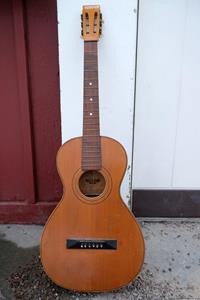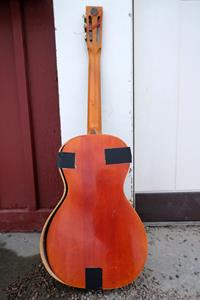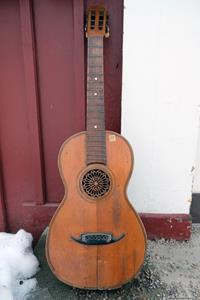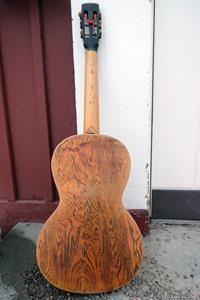I still have some laggards in the previous batch, mostly those that have not been sold yet. But I went through my queue this weekend and five guitars in turn are in the shop and will start working on. As always, it's a mixed bag with Levin and European parlor guitars. Some in good condition and others genuine "wrecks" that require a little more glue :-)
GG174 Levin 1920, fixed bridge
This is one of three Levin 1920 parlors from one and the same customer with serial numbers in a row! One has already been given a simpler renovation, but the other two will be real GammelGura. This one was in good condition and equipped with a fixed bridge.
GG175 Levin 1920, floating bridge
The second of the three in sequence was not in as good condition, to say the least. It will be easy to take it apart when the bottom is already loose! This one had a floating bridge and a "mickey mouse" tailpiece.
GG176 European
The one in best condition was this one. Probably German and made around 1910, but it may be older than that. It has "wrong-turned" tuning screws, ice-cone heel and a typical mother-of-pearl rosette. The bridge is a bit more unusual as it is very straight and simple and not a mustache bridge that is usually the norm. Nice maple in the bottom!
GG177 European, No. 23 from the waiting room
This guitar is probably not as old as it looks, I may be wrong. It was a period in the 1920s and 1930s in Germany when they made guitars in the old style with e.g. mustache stall and ice cone heels. Sometimes even a fingerboard at the height of the top and wood tuning screws to imitate Renaissance guitars. This one has a very nice sound hole decoration, old tuning screws and mustache bridge, but also an adnustable saddle that breathes 1930s. At some point, it has probably been in water or received a proper blow to the end plug. This one will also be easy to take apart :-)
Addendum: Got the guitar apart and I think it is really old, about 1900 or even. 1800s. Beefy tuners, no bridgeplate and visually old hot hide glue and wood make me change my mind. The adjustable intonation plate on the bridge is original, but the time around 1900 was also the time for many inventions on guitars where metal was used in many ways. The decoration in the sound hole is a separate piece of wood that has been carved out and glued to the inside of the top.
GG178 Parlor with ornate bridge
The oldest guitar in the collection is probably this one, I guess in the 1890s. Could be Swedish made, I recognize the natural color neck from other old Swedish parlor guitars and the slightly clumsy body shape. The surprising bridge can be thought to be original, it is at least the same spirit as the KB guitars from the turn of the century 1900. It can also be a later addition. Even if the bridge is not optimal for the perfect sound, it must be allowed to remain. I have to do what I can and adjust the bracing accordingly!
Addendum: It was not visible in the pictures, but the lid is really deformed where the stable rotated in. That it is old is no doubt, no stable plate and the third bar placed behind the stable instead of in front as it should. The lid was also unusually thin, about 2,5 mm. The decoration at the stable is a whole piece of wood with the rectangular stable glued on top.













